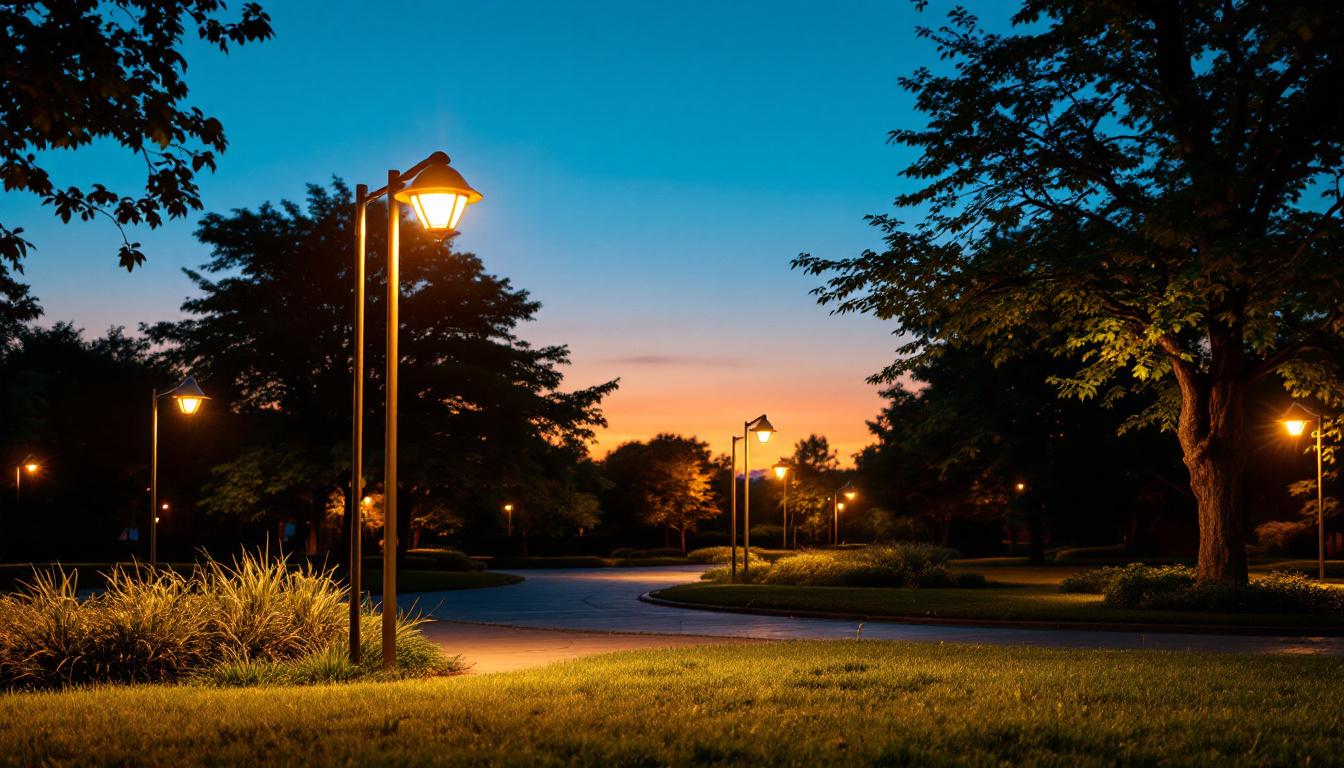
Lighting plays a crucial role in enhancing the safety, aesthetics, and functionality of parks across Canada. As a lighting contractor, understanding the intricacies of park lighting projects is essential to ensure that installations meet both client expectations and regulatory standards. However, navigating the complexities of these projects can lead to costly mistakes if not approached with careful planning and consideration. This article explores common pitfalls in park lighting projects and offers strategies to avoid them.
Effective planning is the cornerstone of any successful lighting project. It sets the stage for all subsequent phases, from design to installation. Without a solid plan, projects can quickly spiral out of control, leading to budget overruns and missed deadlines.
Before any design work begins, it is vital to have a thorough understanding of the client’s needs and expectations. This includes discussing the intended use of the park, the desired ambiance, and any specific safety concerns. Engaging with the client early in the process helps to clarify objectives and can prevent misunderstandings later on.
Additionally, considering the demographics of park users can inform decisions about lighting levels and styles. For instance, a park frequented by families may require softer, warmer lighting to create a welcoming atmosphere, while a park used for sports activities may need brighter, more focused illumination. Understanding the peak usage times and seasonal variations can also influence the planning process. For example, parks that host evening events or festivals may need enhanced lighting solutions that can be adjusted or intensified during those specific occasions.
A comprehensive site assessment is another critical step in the planning phase. This involves evaluating the physical characteristics of the park, including existing infrastructure, vegetation, and topography. Understanding how these elements interact with light can help in selecting the right fixtures and placement.
Moreover, a site assessment should also consider environmental factors such as light pollution regulations and the impact of lighting on local wildlife. Failing to account for these aspects can lead to non-compliance issues and potential harm to the ecosystem. Additionally, it is essential to assess the existing electrical infrastructure to determine whether upgrades or modifications are necessary to support the new lighting system. This assessment can also identify potential challenges, such as the need for trenching or the installation of new circuits, which can significantly affect project timelines and budgets.
The selection of appropriate lighting fixtures is paramount in achieving the desired outcomes for park lighting. The right fixtures not only enhance visibility but also contribute to the overall aesthetic of the space. Thoughtfully designed lighting can transform a park into a welcoming environment, encouraging evening use and enhancing safety for all visitors.
There are various types of lighting fixtures available, each with its own advantages and disadvantages. For instance, LED fixtures are energy-efficient and have a long lifespan, making them a popular choice for park lighting. However, they can be more expensive upfront compared to traditional options like incandescent or fluorescent lights. The initial investment in LED technology often pays off over time through reduced energy bills and lower replacement costs, making them a wise long-term choice for park management.
It is essential to evaluate the specific requirements of the project when choosing fixtures. Factors such as the required lumen output, color temperature, and beam angle should all be considered to ensure that the lighting meets the needs of the park’s users. For example, warmer color temperatures can create a cozy atmosphere, ideal for family-oriented spaces, while cooler temperatures may be more suitable for areas designed for sports and activities, promoting alertness and focus.
Another aspect to consider is the maintenance and durability of the chosen fixtures. Parks are often exposed to harsh weather conditions, and lighting fixtures must be able to withstand these elements. Selecting fixtures with appropriate IP ratings for water and dust resistance can prevent premature failure and reduce maintenance costs. Additionally, fixtures made from corrosion-resistant materials can extend their lifespan, ensuring that the park remains well-lit and inviting for years to come.
Additionally, opting for fixtures that are easy to maintain can save time and resources in the long run. Features such as tool-less access for bulb replacement or modular designs can significantly simplify maintenance tasks. Furthermore, incorporating smart lighting technology can enhance the functionality of park lighting systems. These systems can be programmed to adjust brightness based on the time of day or occupancy levels, providing an energy-efficient solution that adapts to the park’s usage patterns while reducing the need for frequent manual adjustments.
Safety and security are paramount in public spaces, and lighting plays a crucial role in enhancing both. A well-designed lighting scheme can deter crime and reduce accidents, making parks safer for all users.
One of the primary considerations in park lighting design is the illumination of pathways and entrances. Ensuring that these areas are well-lit is essential for guiding visitors safely through the park, especially at night. Pathway lighting should be evenly distributed to avoid dark spots that could pose a safety hazard.
Moreover, entrance areas should be particularly well-lit to create a welcoming atmosphere and enhance visibility for security personnel. This can be achieved through a combination of ambient and task lighting, ensuring that all critical areas are adequately illuminated.
Smart lighting solutions are becoming increasingly popular in public spaces. These systems allow for dynamic adjustments based on real-time conditions, such as the presence of park users or changing weather conditions. Such technology can enhance safety by ensuring that areas are well-lit when needed and conserving energy when they are not.
Integrating smart lighting not only improves safety but also adds a modern touch to park design. Features such as motion sensors and remote monitoring can provide additional layers of security and efficiency.
Cost overruns are a common issue in lighting projects, often stemming from poor budgeting and financial planning. A well-defined budget is essential to keep the project on track and avoid unexpected expenses.
When creating a budget, it is crucial to account for all aspects of the project, including materials, labor, permits, and contingencies. A detailed budget allows for better financial management and helps to identify potential cost-saving opportunities.
Additionally, it is advisable to include a contingency fund to cover unforeseen expenses that may arise during the project. This can help prevent delays and ensure that the project remains on schedule.
Once the project is underway, continuous monitoring of costs is vital. Regularly reviewing expenditures against the budget can help identify any discrepancies early on, allowing for timely adjustments. This proactive approach can prevent budget overruns and ensure that the project remains financially viable.
Compliance with local regulations and industry standards is a critical aspect of park lighting projects. Failure to adhere to these guidelines can result in costly fines and project delays.
Each municipality may have its own set of regulations regarding outdoor lighting, including restrictions on light pollution and specific requirements for fixture types. Familiarizing oneself with these regulations is essential to avoid potential compliance issues.
Moreover, staying updated on any changes to local ordinances can help ensure that projects remain compliant throughout their lifecycle. Engaging with local authorities early in the planning process can provide valuable insights and help navigate any regulatory challenges.
In addition to local regulations, adhering to industry standards is crucial for ensuring the quality and safety of lighting installations. Organizations such as the Illuminating Engineering Society (IES) provide guidelines on best practices for outdoor lighting design.
Following these standards not only enhances the quality of the lighting but also provides assurance to clients that the project meets recognized benchmarks for safety and performance.
Community engagement is an often-overlooked aspect of park lighting projects. Involving the community in the planning and design phases can lead to more successful outcomes and greater satisfaction among park users.
Soliciting feedback from community members can provide valuable insights into their needs and preferences. This can be done through surveys, public meetings, or focus groups. Engaging with the community helps to ensure that the lighting design aligns with their expectations and enhances their experience in the park.
Moreover, involving the community in the decision-making process fosters a sense of ownership and pride in the park, leading to better maintenance and care of the space.
Educating the community about the benefits of proper park lighting can also enhance support for the project. Informing residents about how improved lighting can enhance safety, aesthetics, and usability can create a positive perception of the project and encourage community involvement.
Hosting informational sessions or workshops can be effective in raising awareness and garnering support for the initiative. This not only fosters a collaborative environment but also helps to build trust between contractors and the community.
Park lighting projects in Canada present unique challenges and opportunities for lighting contractors. By understanding the importance of proper planning, selecting the right fixtures, prioritizing safety and compliance, and engaging with the community, contractors can avoid costly mistakes and deliver successful outcomes.
Ultimately, the goal of any park lighting project should be to create safe, inviting, and functional spaces that enhance the overall experience for all users. By implementing the strategies outlined in this article, contractors can ensure that their projects not only meet client expectations but also contribute positively to the community.
Ready to elevate your park lighting projects and avoid costly mistakes? Choose LumenWholesale for your lighting needs and benefit from our commitment to quality, affordability, and convenience. Our spec-grade lighting products meet the highest industry standards, ensuring that your installations are reliable and efficient. With unbeatable wholesale prices and the advantage of bulk buying without hidden fees, we make it easy to get the best value for your investment. Don’t compromise on quality or cost—explore our selection today and see how we can help you create inviting and functional park spaces that the community will love.

Discover the essential components of ceiling fan light kits and why understanding them is crucial for lighting contractors.

Discover the ultimate guide to outdoor solar lanterns for patios, featuring expert insights from top lighting contractors.

Discover the common pitfalls lighting contractors face when installing three-way wall switches.

Discover the essential facts about lamp post lights for outdoor spaces in this comprehensive guide tailored for lighting contractors.